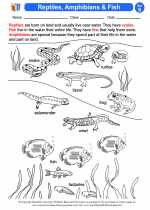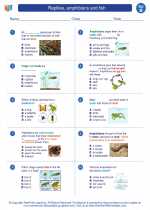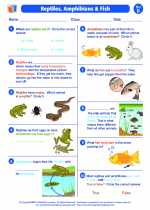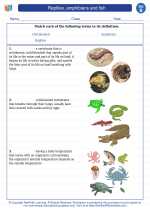Reptiles, amphibians and fish -> domesticated animals
Domesticated Animals
Domesticated animals are species that have been selectively bred and raised in captivity by humans for various purposes, such as food, transportation, companionship, and work. Through the process of domestication, these animals have adapted to living alongside and interacting with humans.
Characteristics of Domesticated Animals
- Docility: Domesticated animals have been bred for a friendly and tractable temperament, making them easier to handle and train.
- Dependence: These animals rely on humans for food, shelter, and care, and may not be able to survive in the wild.
- Reproduction: Domesticated animals often have controlled breeding to maintain desired traits and characteristics.
- Utility: They serve specific purposes, such as providing resources (e.g., milk, wool, meat) or performing tasks (e.g., plowing fields, herding livestock).
Examples of Domesticated Animals
Common domesticated animals include:
- Dogs
- Cats
- Cattle
- Sheep
- Goats
- Pigs
- Horses
- Chickens
- Ducks
- Turkeys
Study Guide
Here are some key points to remember when studying domesticated animals:
- What is the process of domestication and how does it differ from wild animals?
- Identify at least three purposes for which domesticated animals are raised.
- Explain how selective breeding has influenced the characteristics of domesticated animals.
- Compare and contrast the behavior of a domesticated animal with that of its wild ancestor.
- Discuss the impact of domesticated animals on human societies and economies.
Understanding the role of domesticated animals in human history and daily life is essential for appreciating the interconnectedness of humans and the natural world.
.◂Science Worksheets and Study Guides Second Grade. Reptiles, amphibians and fish
Study Guide Reptiles, amphibians and fish
Reptiles, amphibians and fish  Activity Lesson
Activity Lesson Reptiles, Amphibians & Fish
Reptiles, Amphibians & Fish  Worksheet/Answer key
Worksheet/Answer key Reptiles, amphibians and fish
Reptiles, amphibians and fish  Worksheet/Answer key
Worksheet/Answer key Reptiles, amphibians and fish
Reptiles, amphibians and fish  Worksheet/Answer key
Worksheet/Answer key Reptiles, amphibians and fish
Reptiles, amphibians and fish  Worksheet/Answer key
Worksheet/Answer key Reptiles, Amphibians and Fish
Reptiles, Amphibians and Fish  Vocabulary/Answer key
Vocabulary/Answer key Reptiles, amphibians and fish
Reptiles, amphibians and fish 

 Activity Lesson
Activity Lesson
 Worksheet/Answer key
Worksheet/Answer key
 Worksheet/Answer key
Worksheet/Answer key
 Worksheet/Answer key
Worksheet/Answer key
 Worksheet/Answer key
Worksheet/Answer key
 Vocabulary/Answer key
Vocabulary/Answer key

The resources above cover the following skills:
LIFE SCIENCE (NGSS)
Ecosystems: Interactions, Energy, and Dynamics
Students who demonstrate understanding can:
Plan and conduct an investigation to determine if plants need sunlight and water to grow.